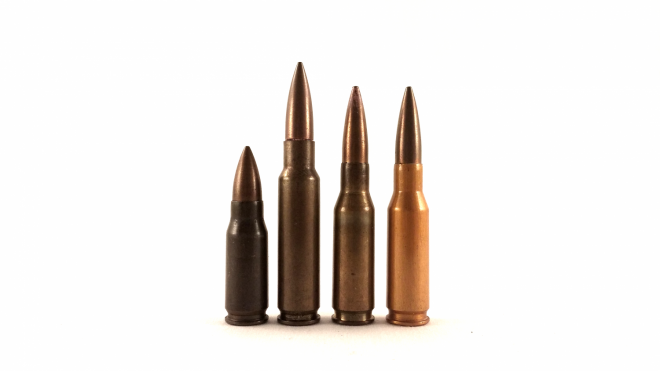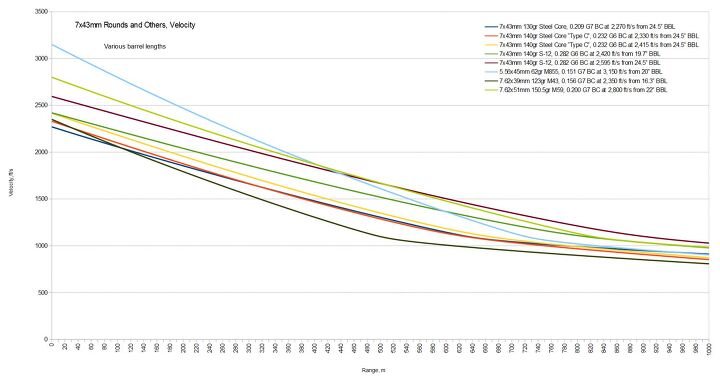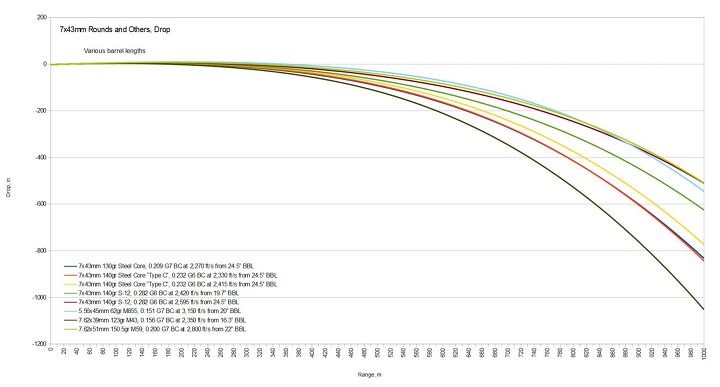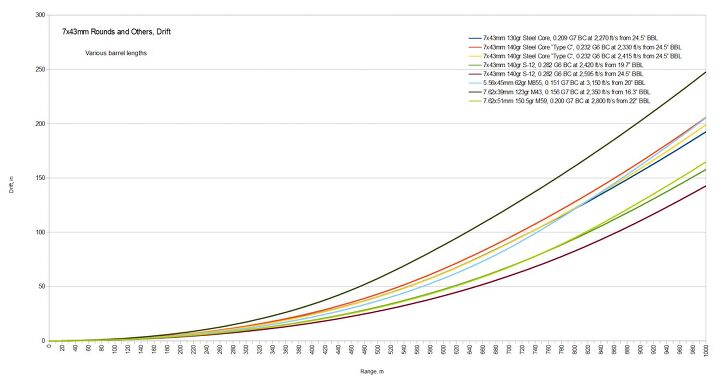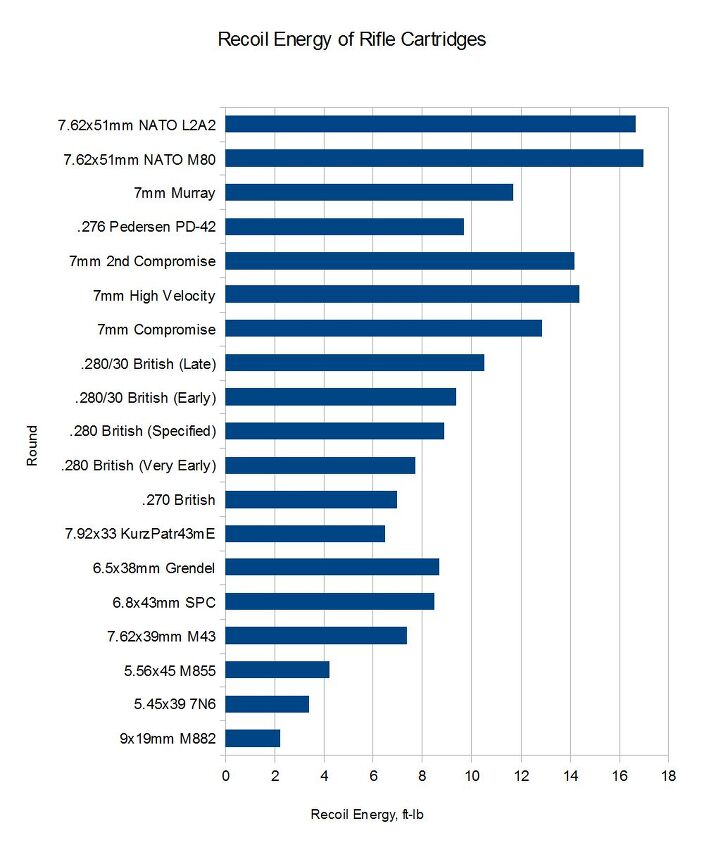Today on an extra special episode of Historical Intermediate Calibers, we’ll be taking a look at one of the most controversial experimental military rounds, one that many believe should have become the standard for the Western World at the beginning of the Cold War. That round is the .280 British, also known as the 7x43mm, and beginning in 1947 it competed head-to-head against the caliber that eventually became the 7.62 NATO in trials to become the standard infantry small arms caliber of the free world. The .280 British has, in the almost 70 years since its invention, become one of the great “might-have-beens” of the small arms ammunition world. Many small arms enthusiasts wonder how firearms history might have been changed if this brilliantly designed British 7mm round had been adopted by NATO instead of the overlarge and too-powerful US-designed 7.62mm.
Was the .280 British really the ballistic marvel that its reputation today suggests? Should it have been adopted instead of the 7.62mm NATO, and if it had been, would development of other intermediate rifle cartridges such as the nascent .22 caliber project that eventually resulted in the 5.56mm have been cut short?
Well, although the .280 is not a poor design by any means, under bright exam table lights it withers a little bit against its stellar reputation. That reputation, and exactly how and why I think it’s not quite deserved, are why I am taking the time to do an extended-length post on the subject. Before we get into that, though, we need to understand what we are really talking about: Chiefly, that the .280 British isn’t just one round, but several. I am not going to get into the history of the round here, because I have a much larger, more detailed post on the subject in the works as part of my series on the US Lightweight Rifle program that resulted in the M14, but let’s take a quick look at some of the different performance variations of the .280 round:
- Early .280 ammunition used a unique 0.458″ diameter case head, and tests in the last quarter of 1949 showed that it propelled a 130gr steel-cored bullet at 2,270 ft/s from a 24″ barrel. This represents the least powerful .280 round developed.
- At the same time, 140gr bullets were being loaded in .280 cases by both FN in Belgium and in the UK. Notes from the period cite a muzzle velocity of 2,330 ft/s from a 24″ barrel for rounds of this type.
- To ease development, the .280 was changed in 1949 to use the same rim dimensions and 0.473″ diameter case head of the US .30 Light Rifle cartridge (which became 7.62 NATO). This variant was called .280/30, and its performance varied depending on the exact propellant and barrel length used. However, for a brief time the objective for this round was a velocity of 2,415 ft/s from a 24″ barrel with a 140gr steel-cored bullet.
- At the end of 1950, the British augmented the performance of the .280/30 by loading a lower-drag 140gr FN S-12 flat-based lead-cored projectile into the case, and firing it at a higher velocity of 2,595 ft/s*. It was this load that was briefly adopted as the 7mm Mk.1Z in 1951 before the program was dropped two and a half years later. *It should be noted that tests from 1952 list the muzzle velocity of this round as 2,660 ft/s, so the 2,595 ft/s figure may be an instrumental velocity.
It should be understood that there were many more variations than these (and even more test results), and that I have just boiled down the development of the .280 to four representative samples so that we can see how they compare with each other. Astute readers will note that the velocity figures for this ammunition are listed as being measured from 24″ barrels (usually a test barrel fixture). Normally, this would imply that shorter barrel lengths would produce lower muzzle velocities (and therefore less recoil), but a report from late 1949 states that the propellant for UK-loaded ammunition had completed burning by just 13.5″ of travel down the barrel. Test results also back up that early .280 and .280/30 ammunition were well past their optimum when fired from 24″ barrels; virtually no velocity loss is shown when shorter 19.7″ barreled FN carbines were tested. This seems to not be true for the higher velocity ammunition, however; tests conducted in February of 1951 in Brasschaat, Belgium, demonstrated that the 19.7″ barreled FN Carbine No. 19 propelled a 140gr S-12 bullet at over 2,420 ft/s muzzle velocity. Given the date, it seems as though this ammunition was the same as the type eventually standardized as the Mk. 1Z, meaning that ammunition was losing significant velocity when barrel length was reduced.
For the purposes of this article, we’ll be looking at ballistics only for rounds fired from the 24.5″ barrel length, with the addition of a calculation based on the results from the Brasschaat test. Four different loads will be examined, which we will call “Very Early”, “Specified”, “Early”, and “Late”. These will use the performance figures of the four bullet points above, in their respective order. I am also going to throw in 5.56mm M855, 7.62x39mm M43, and 7.62x51mm M59 for comparative purposes. Since there’s so much data, I’ve also decided to make the graphs substantially larger for clarity reasons, so readers will want to open the images in new tabs to see them in full size. Without further ado, here are the ballistics:
So what do these graphs show us? Well, ballistically speaking, the .280 seems to be more like two different rounds than one. The three lower velocity loads with British bullets all have ballistic characteristics that look a lot like the Russian 7.62×39, except with better wind drift and somewhat better energy retention. It’s the Belgian load with S-12 bullet and higher muzzle velocity that looks most impressive, with retained velocity and energy, and wind drift characteristics that more resemble the 7.62×51 NATO than they do the other intermediates. The Belgian load only leaves a little to be desired in its mid-range trajectory, as it has a little bit more drop than the 5.56mm and 7.62x51mm rounds, due to its lower muzzle velocity.
The additional performance of the Belgian load (which later became 7mm Mk.1Z) didn’t come free, however, as testers at the time noted that the more powerful ammunition susbtantially ruined the favorable fully automatic characteristics of the guns firing it. In service to a future post, I created a spreadsheet detailing the recoil characteristics of different .280 British loads and other comparable ammunition, and I might as well share it now, so click the link here to download it. A graph from that spreadsheet, showing recoil energy figures assuming a seven pound baseline weapon, is below:
It’s pretty obvious that the later .280/30 British/7mm Mk.1Z load produces substantially more recoil energy than other intermediate caliber weapons. Versus the sometimes challenging-to-control 7.62x39mm, for example, it produces 42% more. However, even the turbocharged Mk.1Z still produces significantly less recoil energy than the larger 7.62 NATO.
One of the things I wanted to help convey in this post is the size and weight of .280 British ammunition, in particular how much larger it is than most other intermediate cartridges. To this aim, I took a few close-up photos of one of my .280/30 cartridges – with a pink tipped “Type C” 140 grain steel-cored bullet – next to other rounds it is often compared to:
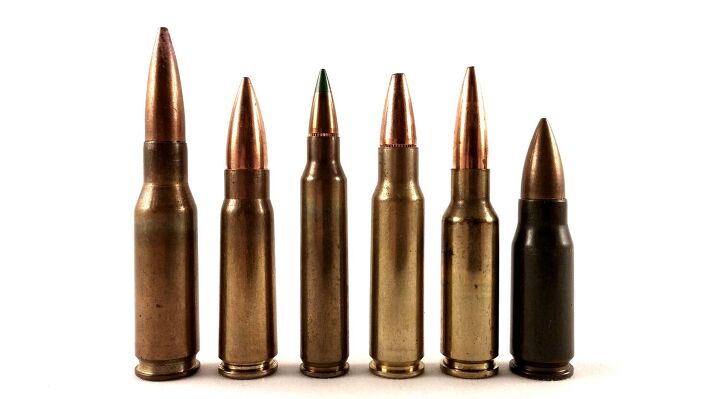
A lineup of some intermediate calibers: .280/30, 7.62×39, 5.56mm, 6.8mm SPC, 6.5mm Grendel, 7.92x33mm Kurz. Note how much larger than all the rest the .280/30 round is. Its size is indicative of its significantly greater bullet weight and case capacity versus all the other intermediates shown here.
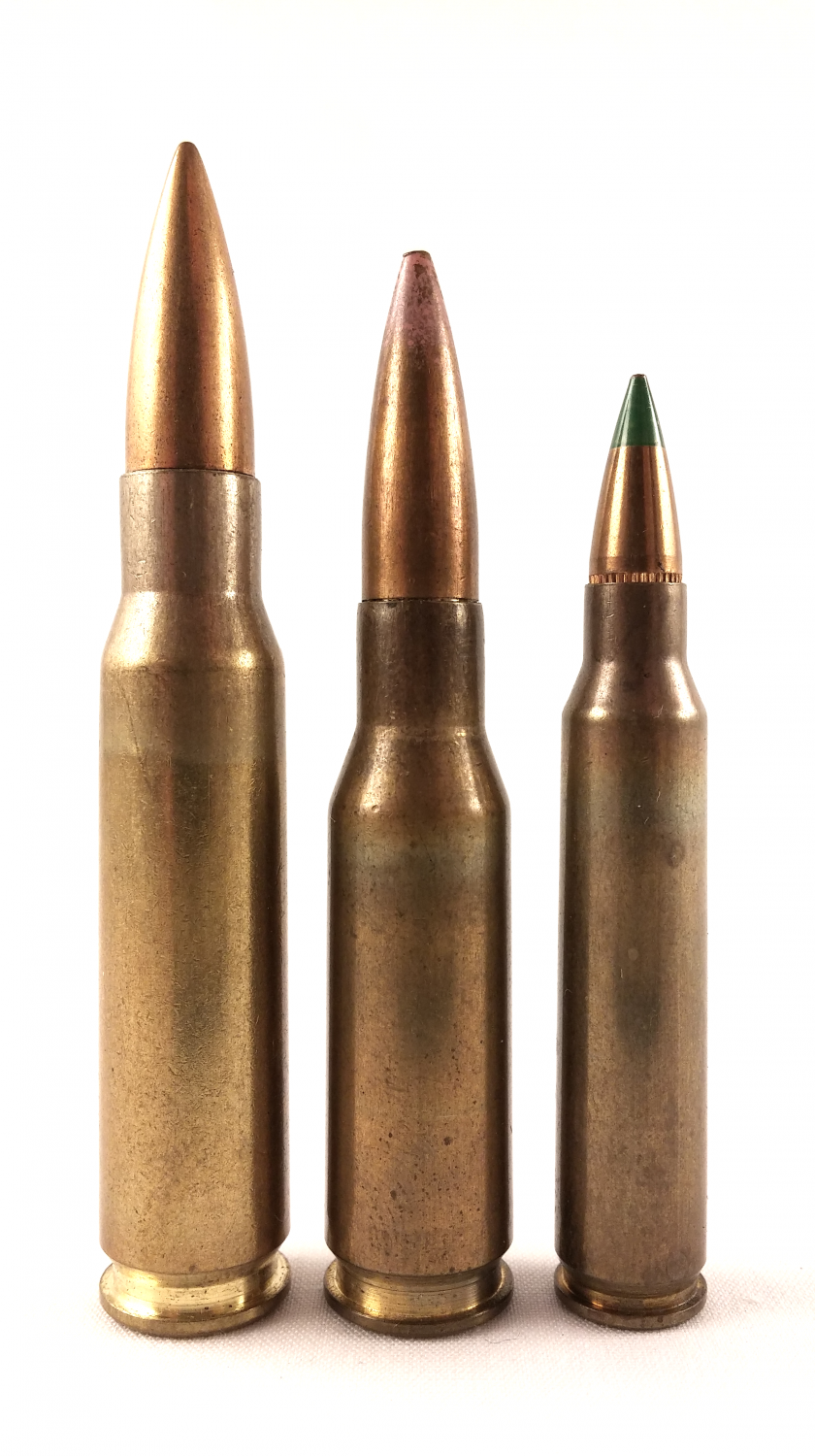
Sometimes it is claimed that had the .280 British been adopted, there would have been no need for the 5.56mm caliber. Speculation aside, the .280 British is more similar in every respect to the 7.62 NATO than it is to the 5.56mm.
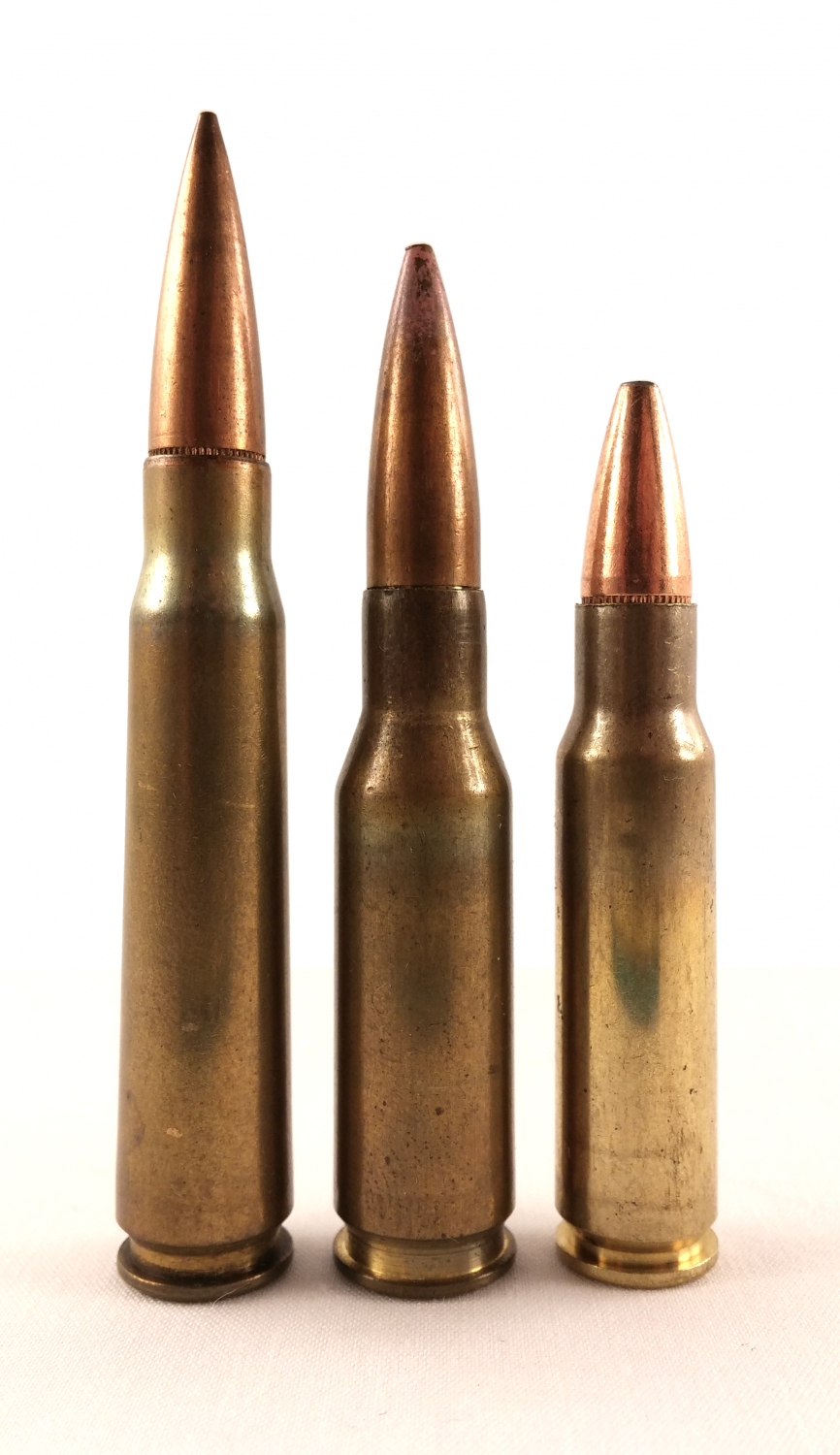
The .280 British is often compared to both the .276 Pedersen and the 6.8mm Remington SPC. In most respects the former comparison holds true, but when compared with the 6.8mm the .280 as it was adopted is substantially larger, heavier, and harsher-recoiling.
It’s can be very difficult to make an accurate size comparison from just photos, especially given the small camera lens I am using, but hopefully these illustrate that the .280 is really on the very upper edge of what would normally be considered “intermediate”.
The .280/30 is a pretty heavy round by intermediate standards, as well; the round shown above weighs 20.8 grams, 21% more than brass-cased 7.62×39. For additional reference, that’s 73% more than the later 5.56mm, while the 7.62x51mm it competed against weighs only 16% more. The British did investigate reducing this weight, however, as the orange-anodized aluminum cased round in the title card demonstrates. That round weighs substantially less, at 14.5 grams. Unfortunately, aluminum case technology never did pan out, although research was conducted for several decades by both the British and Americans.
OK, so with all that done, what do we make of this British .280 caliber? Well, it’s not a bad round. In fact, in a strictly technical sense, I would say it probably was the better concept, versus the American .30 caliber that became 7.62 NATO. However, it seems to me that conflation of the early, more sedate loads, and the later high-performance ones has given many the impression that the .280 was some kind of wonder-round that could do everything and at the same time kicked like a kitten. That is not true.
Should the .280 have been adopted? No, I don’t think so. Although the round was conceptually superior to the American .30 T65, British development of the round experienced significant and lingering problems. The caliber was plagued by poor accuracy when loaded with British steel-cored bullets, and the Belgian S-12 projectile, although relatively low drag and possessing generally excellent characteristics, lacked the ability to penetrate steel helmets beyond 700 meters. In addition, the more heavily arced trajectory of the .280 was never fully ameliorated, except by even larger and more powerful abortive 7mm variants of the American .30 caliber. For these reasons, the American, French, and Canadian delegates to NATO expressed their preference for the .30 T65, and even the British delegates did not commit fully to the .280, instead suggesting the Organization adopt both. Had the Americans embraced the .280 concept and injected more funding and manpower into the effort, maybe it could have succeeded, but even by 1949, when the .280 was still in its infancy, the .30 T65 was already nearly perfected, having had a three-year head start on the British effort. NATO had no reason to choose a less developed, riskier caliber, and the pressure to standardize at all costs was high. Although the choice of the .30 T65 is disappointing to those of us who wonder what could have been, at the time it was probably the right one.
 Your Privacy Choices
Your Privacy Choices
